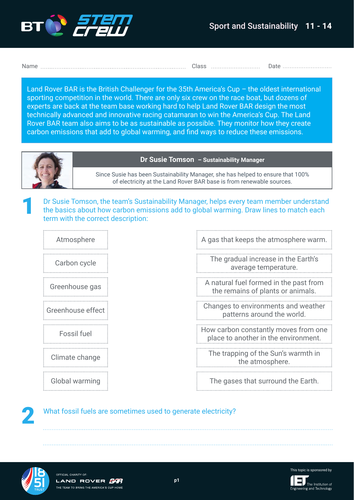



Find out about the carbon cycle and what Land Rover BAR are doing to be as sustainable as possible
This STEM activity looks at the meaning of sustainability and how the team at Land Rover BAR use material technology, design and engineering to ensure that every aspect of the team’s operation is fit for use, designed for purpose and is as sustainable as possible. Activity sheets are used to support and ensure students’ understanding of sustainability and the importance of design and technology when achieving sustainability goals within sport.
This chemistry exercise covers the meaning of the term sustainability and what this means in terms of the carbon cycle. Watch our film below and hear how sustainability experts at Land Rover BAR work to make every aspect of the team’s operations sustainable.
After you have watched our film, complete our worksheets to find out about the carbon cycle and what Land Rover BAR are doing to be as sustainable as possible!
The engineering context
Sustainable engineering is the process of designing systems in such a way that they use energy and resources sustainably. Sustainable engineers make a huge impact on society.
The carbon cycle refers to the process where carbon dioxide travels from the atmosphere into the Earth and then back into the atmosphere. Most carbon is stored in rocks and sediments, while the rest can be found in the ocean, atmosphere and living organisms.
Land Rover BAR
Land Rover BAR is the British Challenger for the 35th America’s Cup – the oldest international sporting competition in the world. There are only six crew on the race boat, but dozens of experts are back at the team base working hard to help Land Rover BAR design the most technically advanced and innovative racing catamaran to win the America’s Cup. The Land Rover BAR team also aims to be as sustainable as possible. They monitor how they create carbon emissions that add to global warming and find ways to reduce these emissions.
Please share your classroom learning highlights with us @IETeducation
Something went wrong, please try again later.
This resource hasn't been reviewed yet
To ensure quality for our reviews, only customers who have downloaded this resource can review it
Report this resourceto let us know if it violates our terms and conditions.
Our customer service team will review your report and will be in touch.